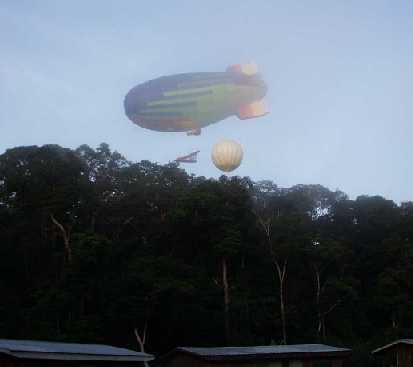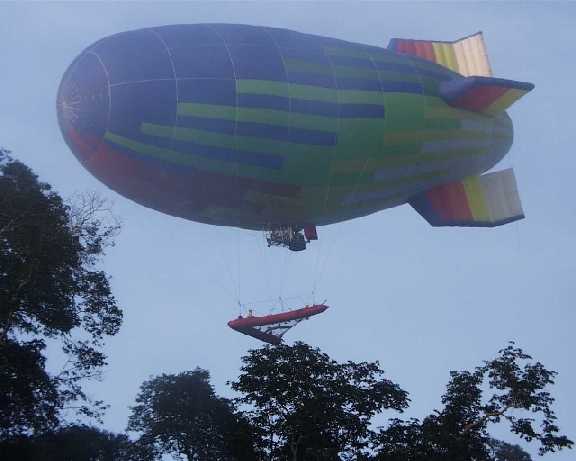

In the first three months of 1999 a major expedition was carried out to the moist tropical forest of West Africa. Focussed on the world´s largest hot-air dirigible airship, the expedition used several new and innovative techniques to reach the highest branches of the huge trees of the Forest of Bees (Fôret des Abeilles), which extends right under the Equator in Gabon. After conducting former comparable expeditions in French Guiana (1989,1996) and Cameroon (1992-93), the French mission leader Professor Francis Hallé (University of Montpellier) and his technical crew from "Oceán vert" brought together 90 scientist from 21 nations at the Campement La Makandé (Forêt des Abeilles) near the Réserve de La Lopé-Okanda in Gabon.
Pro-Natura International, a non-governmental organization, coorganised the expedition. In addition, chemical, pharmaceutical and perfumery and flavouring companies used the facilities for commercial research. Pro-Natura has developed a legal framework which binds these companies to disclose their research to an appropriate institute in the host country insofar as it is not commercially sensitive. Furthermore, a percentage of the profits from any product which is developed from the research they carry out will be paid to the host country for use in environmental and sustainable development projects.
More information and a detailed description of the expedition you can find at
Biodiversity
of epiphytes, forest structure and light regime
of an equatorial rain forest - An integrative analysis
A research project of
Dr.
Stefan Engwald, biologist, University of Bonn
Dr.
Jörg Szarzynski, geographer, University of Mannheim
Dr.
Oleg Panfyorov, meteorologist, University of Göttingen
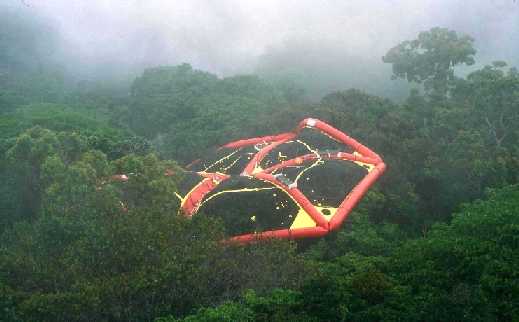
The canopy raft ("radeau des cimes") is a hexagonal semi-rigid structure made of the inflated PVC tubes. Stretched between the tubes is 450 square metres of Aramid netting, which is strong enough to support up to five scientists. The skill and experience of the crew is vital in order to establish a safe working platform, from which the scientists can study the top layer of the canopy. Photo: S. Engwald.
Interdisciplinary
approaches combining data of biodiversity with abiotic factors (e.g. climate
and forest structure) gain increasing attention against the background
of global change research. Usually, this goal is not already implemented
in the experimental design and the execution of field work, as it was
the case in the study presented here.
The scientific focus of our study within the "Operation Canopée" in Gabon
was fourfold:
Solar radiation is
the major energy source for all biological and physical processes in any
plant stand (e.g. photosynthesis, etc.). Within forests the light regime
is characterized by its complex and heterogeneous structure, expressed
by numerous spatial and temporal variations. Intensity and distribution
of radiation play a crucial role within the microclimate of vegetation
stands. Furthermore, the spectral composition of light has a great impact
on many physiological, biochemical and morphogenetical aspects of flora
and fauna. Therefore registration and modelling of the radiation regime
represents an essential part in research of terrestrial ecosystems. Information
derived from the goals 2 - 4 were necessary to evaluate a three-dimensional
radiation model, originally developed for a temperate coniferous forest
in Germany.
Vascular epiphyte biodiversity and abundance on the African continent
are unlike poorer than in the neotropics or in Asian tropical rain forests.
African paucity of epiphytes on higher taxonomic level (families) resulted
from a cool and dry Pleistocene climate, which caused a decline of humid
forest habitats. Also the essential lack of important epiphytic families,
like neotropical Bromeliaceae and Cactaceae, is to be considered as another
reason. However, the African continent contains a considerable number
of epiphytic orchids and ferns. The knowledge of vascular epiphytes of
Central Africa is very restricted and only a few works are published.
No comparable works can be cited for the study area and species inventories
of arboreal flora in rain forests of Gabon remained so far incomplete
due to the difficulties in canopy access.
The dirigible, equipped with raft or sledge, permitted to reach even tiny branches of the outer zones of epiphyte hosting trees (phorophytes). The presented interdisciplinary approach attempts to link climate parameter with questions of biodiversity of arboreal flora (vascular epiphytes). However, the analysis of our data obtained during the two week field stay is still in process.
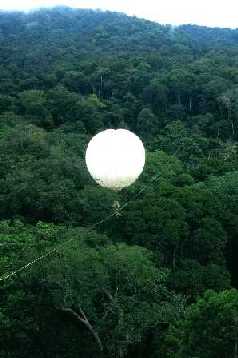
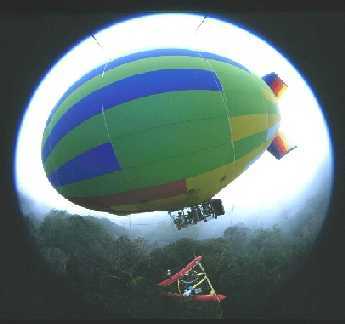
The dirigible aircraft with sledge ("la luge") on his early morning flight over the treetops of the Forêt des Abeilles. Only between 5 and 9 a.m. the dirigible can be moved with accurately, without being influenced by unpredictible winds. Photo: O. Panfyorov.
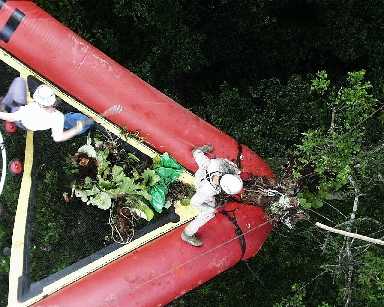
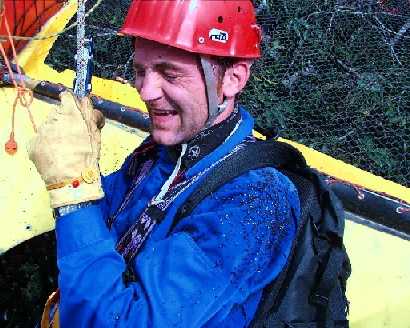

Hundreds of tiny sweat-bees are ready for attack the curious scientist, who reaches the top of the raft. Next time, geographer J. Szarzynski will not forget an appropriate head protection..! Photo: S.Engwald, Figure: TRIPP
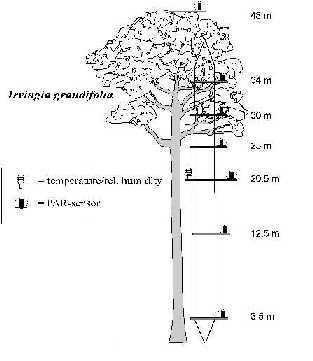
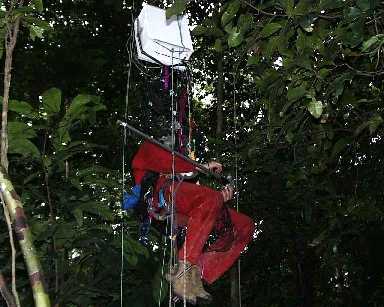
Configuration
of PAR-, temperature- and relative humidity - sensors in an Irvingia
grandifolia-tree. Sensors were installed on aluminium sticks, which
was horizontally fixed between two cables in a rope and pulley system.
(Figure: S. Engwald).
J. Szarzynski is mounting the PAR sensors on aluminium sticks. (Photo:
S. Engwald).

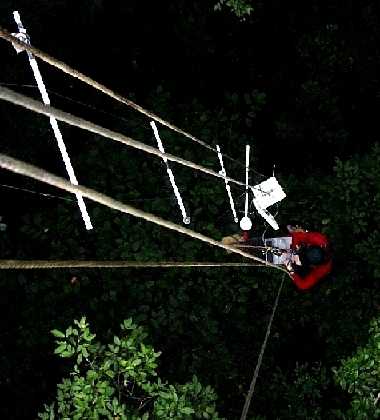

Selected publications
